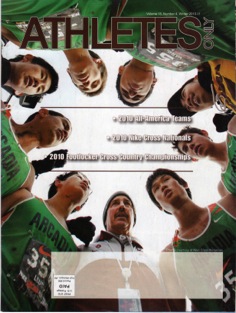Teaching Correct Strength Training Techniques to Young Athletes
By Roy Stevenson

Exercise scientists agree that strength training is necessary for the athlete to maximize his performance in all track and field events. The research is unequivocally in favor of resistance training—it has been shown to improve running economy, improve racing times, increase lactate threshold, maintain a high power output over a longer time, develop a faster finish, increase stride length, and increase core strength and stability.
However, if not taught correctly or not supervised properly, strength training can cause injuries and muscular imbalances. Here’s how to ensure that your track and field team gets the most out of their strength training without running into these problems.
The key teaching points for teenage weight trainers revolve around emphasizing and enforcing correct technique, and working out in a safe weight room. The coach must learn the correct technique (or recruit an experienced weightlifter to demonstrate correct technique), and provide feedback to the athletes as they work out.
When teaching the correct technique for each lift, emphasize the proper grip, breathing out while you lift and breathing in when you lower the bar. Correct adjustment of the machines to the athlete’s size is vital because most machines are designed to fit the average adult, and many of your shorter athletes will have difficulty fitting into the machines correctly. When possible, use pads to boost shorter athletes, or to move them forward on the equipment. The idea is to have the athlete’s joint in line with the axis of rotation on rotary machines, and correctly aligned with the bar in linear movements. Do not use machines if the athlete is not properly aligned.
To ensure correct technique, start with light weights and progress as the athlete’s form improves on each exercise. Especially, watch for boys using other muscle groups than the target muscles, to lift heavier weights. This is easy to spot because they’ll be cheating with each repetition. e.g. using the back muscles to start the arm curl exercise. Attempting to use a heavier weight than the athlete can handle is one of the most common things you will encounter.
While the athlete is doing each set, give them specific feedback on how to improve the exercise. Feedback needs to be immediate so the athletes can “feel” the muscles while they are moving. And feedback is important for the experienced weight trainer too—this prevents the permanent adoption of flawed movements.
Progressively increasing the resistance may cause problems if the machines have stacks that come in large increments. This is more common with older weight equipment. Also make sure you have lots of smaller free weights of 2.5-lbs and 5-lbs to enable a smooth progression to heavier weights.
The safety of your young charges is paramount, even rating above performance in the weight room. Emphasize and insist on safety first. This includes always using collars with free weights, and having the athletes work in pairs, so there is always a spotter to assist. Using a spotter has many advantages, apart from increased safety. Spotters can correct improper technique, and studies show that lifters using spotters to help them with the last few repetitions have greater strength gains compared with doing a workout solo.
In closing, remember the psyche for teenage boys and girls. Boys will want to lift as heavy a weight as they can, while girls are concerned that weight training will make them large and muscular. Both of these concerns should be addressed at the first strength training session.
You might also be interesting in other running information
Return from Strength Training to Running Articles
Return from Strength Training to Home Page